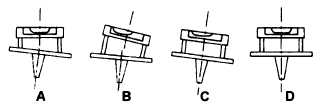Figure 6-1.—Adjusting the level tube.
ADJUSTING THE LEVEL TUBE.— The vertical
axis of rotation of the instrument is the basis for all
adjustments to the engineer’s level. When the
instrument is set up and leveled the vertical axis of
rotation and the longitudinal axis of the level tube should
be perpendicular to one another. If they are not
perpendicular, then the vertical axis cannot be made
truly vertical. Adjustment of the level tube makes the
axis of the level tube perpendicular to the vertical axis.
To check and adjust the level tube, you should follow
the procedures below:
1. Setup the instrument and approximately level
the bubble over each pair of opposite leveling screws.
Then carefully center the bubble over one pair of screws,
as shown in view A, figure 6-1.
2. Rotate the instrument 180°. If the bubble
remains centered, then the level tube is in proper
adjustment. If the bubble does NOT remain centered
note the movement of the bubble away from center
(view B, fig. 6-1).
3. Bring the bubble half the distance back to the
center of the tube by turning the capstan nuts at one end
of the tube (view C, fig. 6-1).
4. Relevel with the leveling screws (view D, fig.
6-1) and rotate the instrument again. Repeat Step 3
above if the bubble does not remain at the center of the
tube.
5. Check the final adjustment by noting that the
bubble remains in the center of the tube during the entire
revolution about the vertical axis.
NOTE: When the level tube is out of adjustment,
you can compensate for it by releveling the instrument
before each sighting.
ADJUSTING THE HORIZONTAL CROSS
HAIR.— For the horizontal cross hair to lie in a truly
horizontal plane when the instrument is leveled, the
horizontal cross hair must be perpendicular to the
vertical axis. To make the horizontal cross hair (fig. 6-2)
lie in a plane perpendicular to the vertical axis, you
should perform the following steps:
1. With the instrument carefully leveled, sight one
end of the horizontal cross hair on a well-defined point
at least 250 feet away. Turn the telescope slowly about
the vertical axis, using the slow motion screw. If the
cross hairs are in adjustment, the horizontal cross hair
will stay on the point through its entire length.
2. If it does not stay on the point, loosen two
adjacent reticle capstan screws and rotate the reticle by
lightly tapping two opposite screws.
3. Sight on the point again. If the horizontal cross
hair does not stay on the point through its entire length,
rotate the ring again.
4. Repeat this process until the condition is
satisfied.
NOTE: To compensate for the above maladjust-
ment, you should use only that part of the horizontal
cross hair that is closest to the vertical hair for all
sightings.
ADJUSTING THE LINE OF SIGHT.— For a
perfectly adjusted level, the line of sight is parallel to the
axis of the level tube. When the level meets this
condition, the line of sight will generate a truly
horizontal plane when the instrument is rotated. When
Figure 6-2.—Adjusting the horizontal cross hair.
6-4







